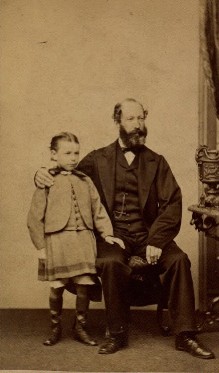
John Murray Wighton (approx. 7-8 years old) with his father, John Baxter Wighton (42 years old).
| The Meigle Wightons |
| Generation 6: John Murray Wighton (1857 to 1924) | |
 |
|
|
John Murray Wighton (approx. 7-8 years old) with his father, John Baxter Wighton (42 years old). |
|
| Grandparents | John Wighton and Ann Baxter | John Latta (?) & Sarah Lang (?) | William Hutcheon & Catherine Heckton | John Burns & Catherine Blues | ||
| Parents | John Baxter Wighton | Catherine Latta | Alexander Hutcheon | Margaret Strachan Burns | ||
| Our Gen.6 Ancestors | John (Murray) (b. 1857) | wed (1885) | Amy Louisa Hutcheon (b. 1860) | |||
| John (Murray)'s Siblings | Ann (b.1854) | Harry (b.1861?) | Fanny (b.1865) | |||
| John (Murray)'s Children | Harry (Latta) (b.1886) | Ella (Burns) (b.1887) | Amy Louisa (b.1891) | |||
|
John's infancy John Baxter Wighton and Catherine Latta left Canada in 1854 and arrived in Great Britain in 1855. Catherine was in Dundee when their first born child (Ann) died in 1855 at her father-in-law's home at the Overgate. Presumably she stayed with her in-laws while her husband was fighting in the Crimea. John Baxter returned from the Crimea War in June of 1856 but was stationed briefly in Aldershoot, England before being garrisoned in Guernsey Island in August of 1856. He remained there until April of 1857 and it's a reasonable assumption that Catherine traveled from Dundee to be with him since their son would have been conceived about February, 1857. John Baxter's regiment was relocated back to England in the summer of 1857 and presumably Catherine remained with him until John's regiment left for the Crimea in September of that year. Catherine returned to Dundee and gave birth to a son on November 16, 1857 at 61 Brown Street, the home of the infant's aunt and uncle (Barbara Baxter Wighton and Alexander Lees). It's fair to say that every parent wants to give their children a good start in life. The parents of Thomas Wighton (Gen. 3), for example, found the way to apprentice him as a stone mason to help him find a living away from a crofter's tiny plot of land. Thomas, in turn, found a way to give his son John (gen. 4) the advantage of an apprenticeship in shoemaking - a respectable trade. John Baxter Wighton and Catherine Latta gave their gift to their son on his christening day. They gave him a middle name. Now, middle names were not uncommon by this time in Scottish life. Witness, for example, that John Baxter Wighton's middle name was derived from his mother's maiden name - a common practice in naming children at that time. Grandmothers were also a common source - for example, Elizabeth Taylor Wighton was named after her paternal grandmother, Elizabeth Taylor. However, John Baxter's and Catherine Latta's choice of middle names went waaaaaay back - to their son's great-grandmother, and it was a very special middle name. To learn more, click John Baxter and Catherine Latta's gift. It's difficult to know where JMW lived during his early childhood years. It's possible that Catherine Latta and he stayed with the Lees family for some time. At some point during John Baxter's service in India, perhaps as early as 1860 or 1861, Catherine joined him. She probably took John Murray with her since I found no reference to him living with his aunt or with his grandparents in the 1861 census. Presumably then, John Murray returned to England with his father and mother in 1865, and shortly afterwards, travelled to Dundee where he had his picture taken with his father, as shown at the top of this page. John Murray Wigton reappears in the census records in 1871 when he was living with his father, mother, and 6-year old sister Fanny in Montrose. He is recorded as 13-years old at the time. At some point in his teens or early 20s, John left the family home in Montrose and struck out on his own. We know, for example, that he was a reporter for a newspaper in Newcastle on Tyne, more than 200 miles south of Montrose in Central, East England. This may have been around 1881 as I was unable to find him in that census in Scotland. (JBW, Catherine Latta, and 16 year old Fanny were still in Montrose.) John Murray would have been around 23. (I wasn't able to find him in the England census of 1881 either.) |
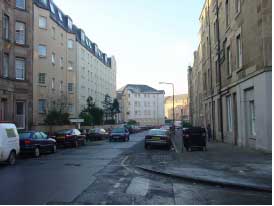 |
|
The view from the current Caledonian Terrace, Edinburgh. |
|
We learned from a letter from the Scottish Prison Service that in 1882, JMW was staying at Caledonian Terrace, Edinburgh. (See picture above.) The Caledonian area was a network of 4 streets, dominated by high density tenement dwellings within the inner city. It was less than a mile from the Princess Street Gardens and Edinburgh castle. John entered Scotland's civil service on October 16, 1882 and was engaged by the Scottish Prison Service as a clerk engaged in purchasing supplies for the prison in which he was working. We don't know for sure where his first assignment was, but in 1885, he was working at the prison in Perth. It is entirely possible that Perth Prison was his first posting. As you'll read soon, a position in the Civil Service was considered a desirable middle class job with its "white collar" working environment, steady employment, and reasonable pay. We don't know what prompted JMW to seek this position, especially given that his first employment was as a newspaper reporter. It's possible that John Baxter Wighton provided his son with an "in" to the service. JMW's job as a clerk engaged in acquiring supplies within a military-like environment sounds very much like his father's quartermaster job within the army. Personal contacts and supportive connections were important in gaining entry to a profession during this period and John Baxter Wighton would have been highly regarded within the ranks of the non-commissioned military. Alternatively, it's also possible that JBW had made contact with the Mansfield family by this time and a word from that family would have speedily opened a door. Here's an essay you can read if you're interested in learning more about Crime and Punishment in Scotland in the 17th, 18th and 19th centuries. There are two other essays which I wrote for previous Wighton ancestors and which you probably have already read. You might want to re-read them since they also deal with crime and punishment in early Scotland: Kirk Sessions and The Pillory and other Punishments. Life in Victorian Britain when JMW was an adult I touched very briefly above on the role of the aristocracy in Britain during John Murray's life. This essay on Social Classes in Victorian Britain will give you the background that will allow you to better appreciate some of the events in John Murray's life. Marriage in Dalkeith and Life in Perth |
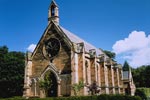 |
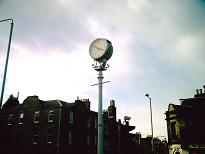 |
| Chapel of St. Mary in Dalkeith |
Craigie Clock, Priory Place, Perth |
|
John Murray Wighton married Amy Louisa Hutcheon on June 15th, 1885 at St. Mary's Chapel, Dalkeith after banns according to the Episcopal Church of Scotland (same as Anglican Church of England). At the time, JMW was a member of Her Majesty's Civil Service and was employed at the General Prison, 38 Princess Street, Perth. Amy Louisa Hutcheon, the daughter of a ship's captain, was 24 years old at her marriage. She was born and raised in Montrose, Scotland and met John through his sister, Fanny who attended the same teaching college in Edinburgh as Amy Louisa. (I'll give you more information about where they got married in Amy Louisa's biography.) After the wedding, John and Amy Louisa settled in Perth at 5 Priory Place. Above right, you'll see Craigie Clock situated at Priory Place at about the turn of the century. Behind it, you'll get a sense of the types of accommodations that were on that street. It's difficult to know the exact address where John worked. His marriage certificate gives his place of work as 38 Princess Street which is in the downtown core, close to the Scottish Episcopal Church. According to Google satellite images, this is not a residential area, nor was it likely to be one at the time. However, HM Prison Perth was located at 3 Edinburgh Road, about half a mile south. I suspect that the business of ordering supplies for the prison was done out of an office building rather than in the prison itself, so the Princess Street address was the most likely place that he worked. John's home on Priory Place was a half mile (south-east) from the prison and 0.8 mile (north-east) from the presumed office building. Either way, he was within a ten minute walk of work. John and Amy Louisa had three children within five years.
|
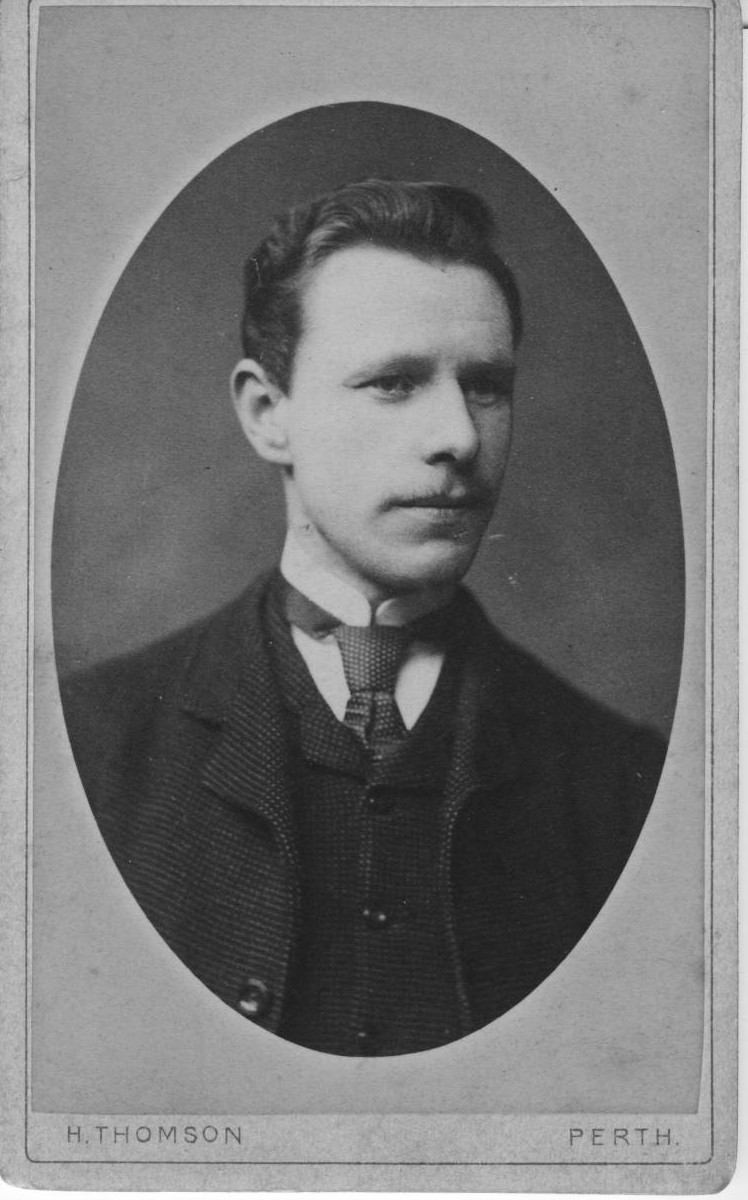 |
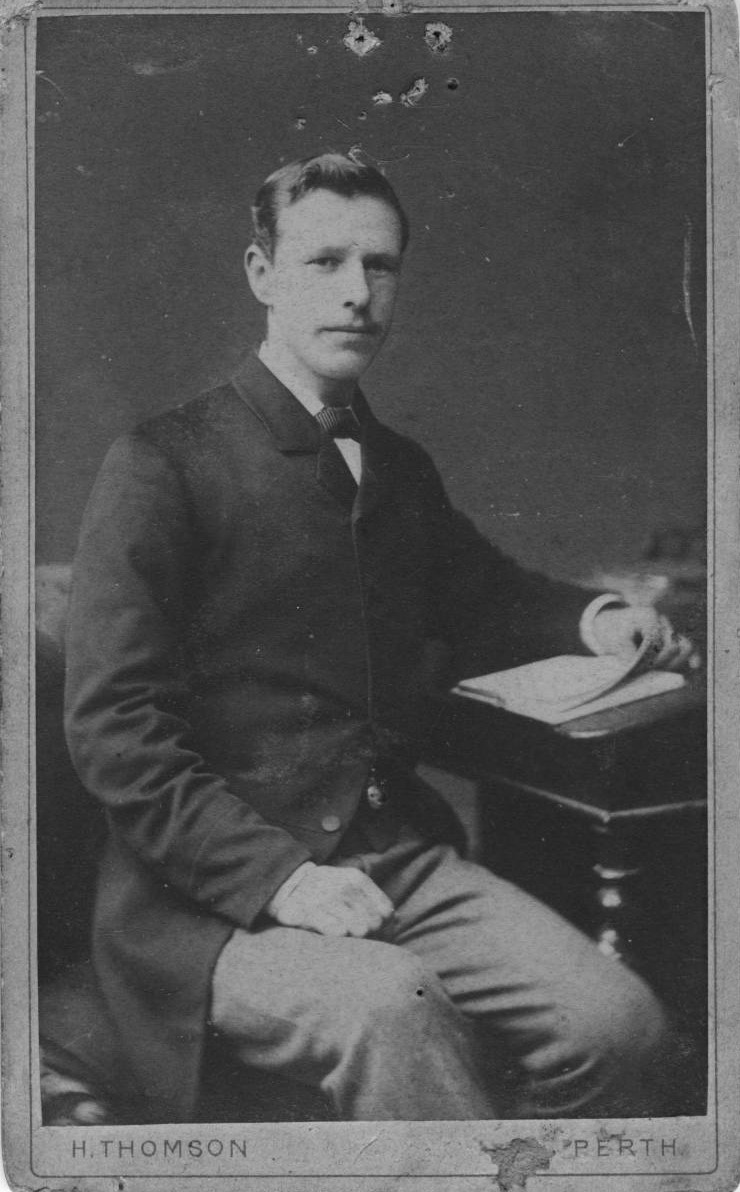 |
|
Above are two pictures taken in Perth. The one on the left was taken in 1885 when John was 28. The other was undated but was clearly taken within a few years of the other. Both pictures show John Murray in his late 20s or early 30s. The years that John spent in Perth must have been very exciting. Starting in a career, newly married, 3-young children, rubbing elbows with distinguished gentlemen and Lords... Oh, right.... you don't know about this last bit yet. That means that you'll have to read this essay about Perth's Conservative Club. Here's another thing that you don't know about John. In fact, there was no reference in any of the family's oral history about John's secret career. I found it by accident when I came across the Street Directory for Perth in 1887. This directory was like our telephone directory but without the telephone numbers. They had listings by surname and by street address. And yes, they had advertising. One such ad was for the Caledonia Insurance Company and way down at the bottom of the ad, they listed their agents in Perth. Included was John Wighton, 5 Priory Place. I don't know how long John continued this second job. I suspect that once he got involved with the Conservative Club, he dropped it. But, it's interesting to see that he took on two jobs with his young family. Oh, and what's this below? An invitation to the wedding of the granddaughter of an Earl and the daughter of a Viscount? Ho hum.... |
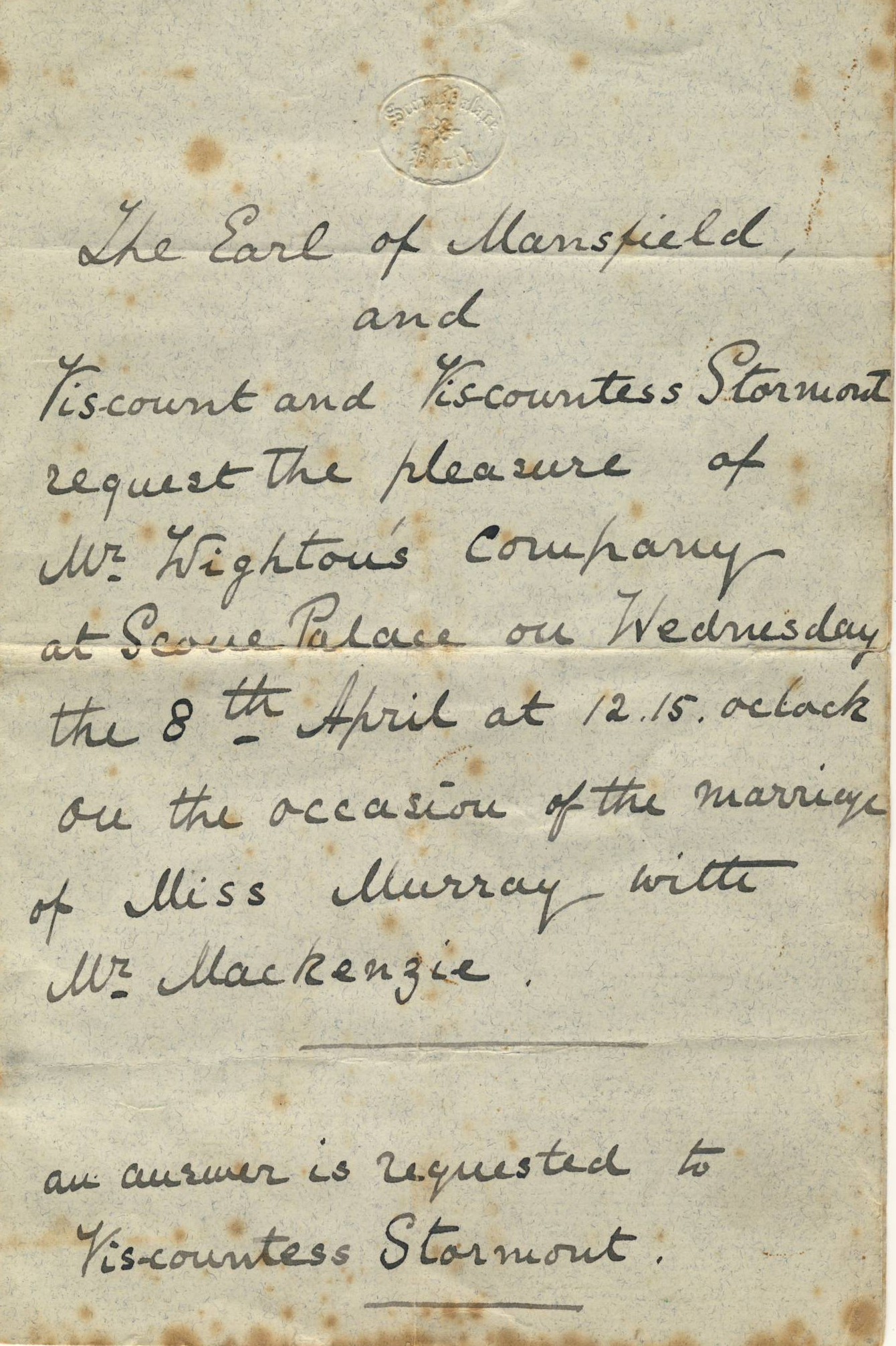 |
|
The wedding invitation above came from William David Murray (1806-1898) the 4th Earl of Mansfield and grandfather of the bride. The father of the bride was Viscount Stormont, the first son of the 4th Earl, who was also christened William David Murray. He was born in 1835 and died in 1893. A picture of Viscount Stormont was at the top of the essay you just read on the Conservative Club. Viscount Stormont married Emily Louisa MacGregor in 1857 and the couple had 7 children - 2 daughters (Marjory and Mabel) and 5 sons (William David Murray, Andrew David Murray, Alan David Murray, Angus David Murray, and Alexander David Murray. (They sure liked the name David, didn't they? Or, perhaps they just had a lot of handkerchiefs with the monogram ADM already inscribed on them.) (Incidentally, the Earls of Mansfield weren't all named William David Murray. The 3rd Earl, for example, was named David William Murray.) The Miss Murray getting married was the first daughter - Marjory Louisa Murray - and that wedding took place April 8, 1891. The groom was Sir Kenneth John Mackenzie and he later became 7th Baronet Mackenzie of Gairloch. The couple's middle child was named Hector David Mackenzie... yet another David. Marjory's younger sister, Mable, married Admiral Sir Herbert Goodenough King Hall. I found no mention of any Davids in their offspring. Apparently, having as many Davids as they did in the Murray family was good-enough. In 1891, John was listed in the census as 2nd Class Clerk, Scottish Prison Service, age 33. With him in Perth were Amy Louisa Wighton, his wife, aged 30, Harry Latta Wighton, his son aged 5, and Ella Burns Wighton, his daughter, aged 4. The census records that I obtained did not give his address in Perth. I presume it was the 5 Priory Place location. (His mother, Catherine Latta Wighton, was living in Arbroath at that time. His father, John Baxter Wighton, had died in 1890.) The picture below is probably from the early 90s. You can see the John is a little older than the earlier individual shots; note that some of the hair from his head has migrated to his moustache. |
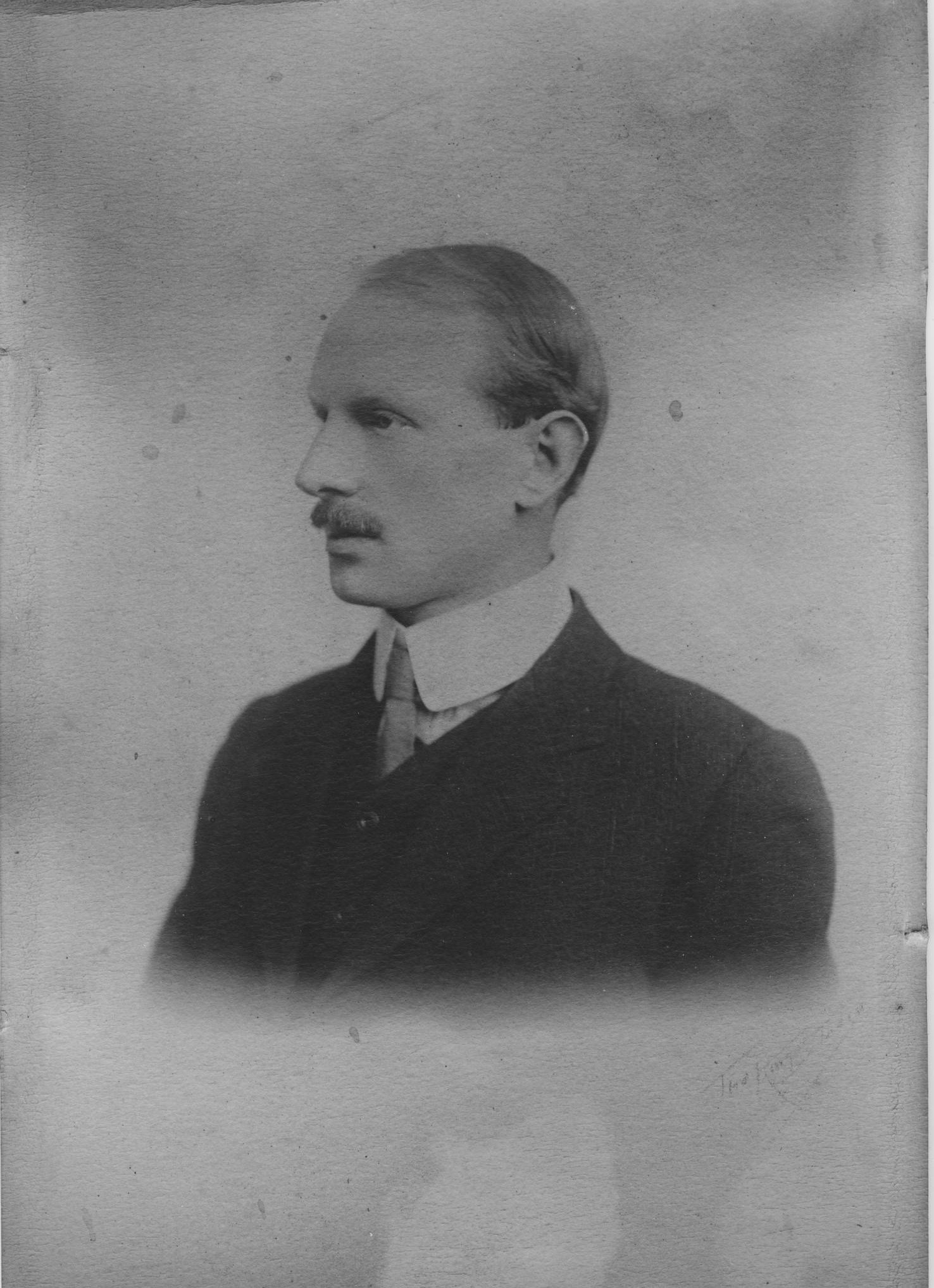 |
|
John and the Conservative Club |
|
As detailed in the essay above about the Conservative Club, John was heavily involved as the Secretary of the club. It was through that involvement that he was invited to the wedding described above. We didn't know what prompted John to resign as Secretary. We do know that he remained in Perth. Thanks to cousin Margaret Serzans, we now know what happened. [Breaking news, breaking news, breaking news....] She found the details by searching through Ancestry's newspapers. She found the article below in "The Courier and Argus", a newspaper published in Dundee on August 14, 1894. I will skip the lengthy list of all the people who attended the presentation to John Wighton the previous evening. I will also skip what gifts John and Amy Louisa received. [Here's what they thought of our ancestor.] "MP Whitelaw, in making the presentation said he had appeared on many platforms, but he did not think that he had ever stood on a platform with more genuine pleasure than he did that night. The success which had attended the Unionist party in Perth in the during the last few ;years had been owing to the endeavors of a number of gentlemen connected with the work of the party. No one had done more for the party than the gentleman whom they had met to honour. [applause] Very few of them knew the immense amount of work Mr. Wighton had done for the party with no recompense. Since Mr. Wighton became Secretary of the Club the progress which the Unionist Party had made in the city was something extraordinary. In the hopeless days for the conservative cause there were men who were determined that it should be more hopeful. [Now here comes the reason John resigned.] "The Prison Commissioners, for whom he had no respect, who were most extravagant as they themselves were concerned, and the most niggardly body in Scotland as far as other people were concerned, had induced Mr. Wighton to give up his official connection with the Club."
"Mr. Wighton, in acknowledging the gifts, said that he was deeply touched by the kindness of his friends in the circumstances attending that function. He expressed his warmest thanks to everyone connected with the Club for the kindness and courtesy he had received. He highly appreciated their handsome gifts, and especially their presents to Mrs. Wighton." |
|
Life after Perth |
 |
|
We don't know exactly when John and his family left Perth. I had initially thought that the departure was in 1894 after his resignation from his position with the Conservative Club. But, in researching for the biography of John's son, I found that Harry would have been attending school in Perth up to about 1900. This suggests that there was some other reason for John to resign his position and the family remained in Perth until Harry had left school. The 1901 Census shows John Murray living with his family in Peterhead in the Parish of Aberdeen and specifically at the Seafield Prison where he was a 1st Class Clark. The family's accommodations consisted of 5 rooms with at least 2 windows. The prison (see picture above) was built around August of 1888. The convict population ranged from 350 and peaked at 455 in 1911. However, John and his family were gone by that time. While living in Peterhead, JMW served as a fill-in organist at St. Peter's Episcopal Church.We don't know exactly when JMW left Seafield Prison, but we do know that he was in Milngavie, about 5-6 miles north of Glasgow by 1908. Unfortunately, the confirmation of the Wightons living in Milngavie was not obtained through a census record, but rather due to a sad event - the death of his daughter Ella Burns Wighton from tuberculosis. Ella was 21 at the time. She was buried at New Kilpatrick Cemetery, Grave #837, Section C, on November 28th, 1908 and it was the cemetery records that gave us the Milngavie address. New Kilpartrick Cemetery is located about 2 miles south of Milngavie. The picture below shows the full family in what is probably the back yard of their residence in Milngavie. From left to right: Ella Burns, John Murray, Amy Louisa, Harry Latta and Amy Louisa (Hutcheon). Since Harry emigrated to Canada in 1907 this photo had to have been taken before May, 1907. If Harry was getting close to leaving, it would make sense that they would get together for a family portrait, so, we might assume the picture was taken in April 1907. That would put Amy Louisa's age at just shy of 16, Ella just turned 20 and Harry, just turned 21. Those look pretty close to me. If not 1907, then 1906. If this picture was actually taken in the back yard of their residence, the background gives you a pretty good idea how well the family was living at the time. Only two generations previous to this, the extended John Wighton (the shoemaker) family was crowded within a very small tenement apartment in Dundee. |
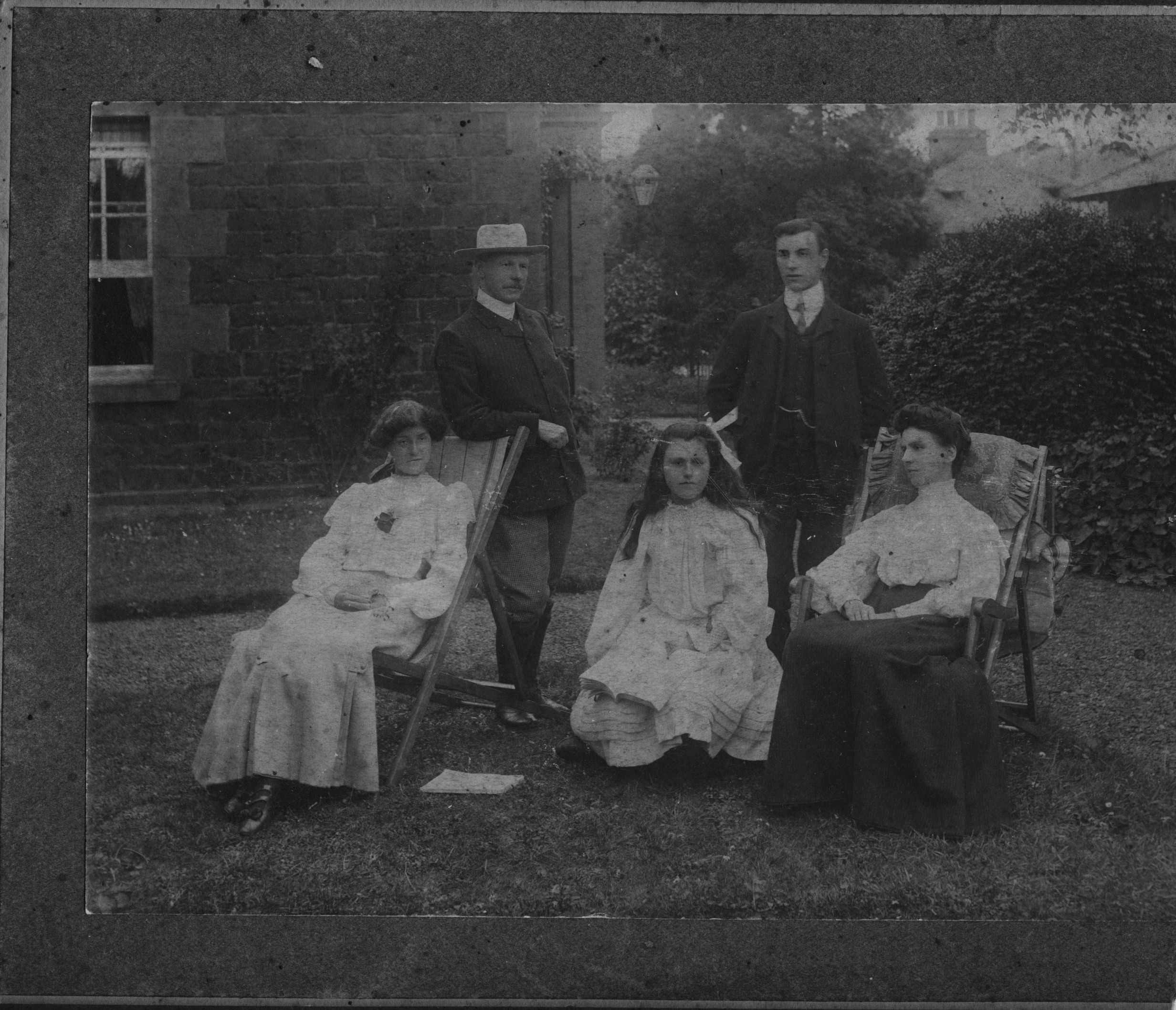 |
|
In 1863, Milngavie was only a small village, but the Milngavie and Glasgow Junction Railway changed all of that. The railway builders had the foresight to realize that it would expand rapidly as a result of the rail link to Glasgow and that the line would carry many commuters. Presumably, the railway allowed John to live outside of Glasgow proper and commute to work at HM Prison Barlinnie (see below) in Glasgow's northeast, a distance today of about 9 miles. Once located outside the city on an excess of farmland, Barlinnie Prison has now been encircled by the city of Glasgow. It is situated in the current residential suburb of Riddrie at 81 Lee Avenue. It first opened with the construction of A hall in July, 1882. Four other halls were added from 1882 to 1897. At the time, each hall held approximately 200 prisoners. Today it is the largest prison in Scotland, regularly holding well over 1,000 prisoners. Barlinnie is the last of Glasgow's eight 19th century prisons that is still in use. |
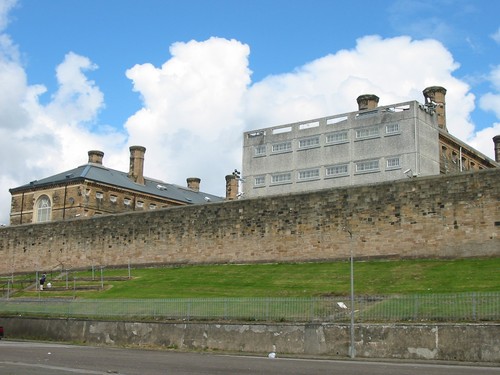 |
|
The 1911 census confirmed John and Amy Louisa's presence at Dunsmere and added the name of the street where this house was located - Mugdock Road. Their daughter, Amy Louisa, was 19 and still staying with them. No employment data were given for her. Also present at the house was a lodger, Mary Kelly, a 78-year old widower. As mentioned, Harry had emigrated to Canada in 1907. His sister, Amy Louisa, would emigrate to the US after WW 1 was over. Presumably, all three Wightons were still living in the Dunsmere house when Harry brought his wife (Miriam) and their 2 infant children (son John and daughter Ella) to Glasgow so that he could support Scotland in the war effort. Harry's third child, James, was born in Glasgow in 1916. Retirement |
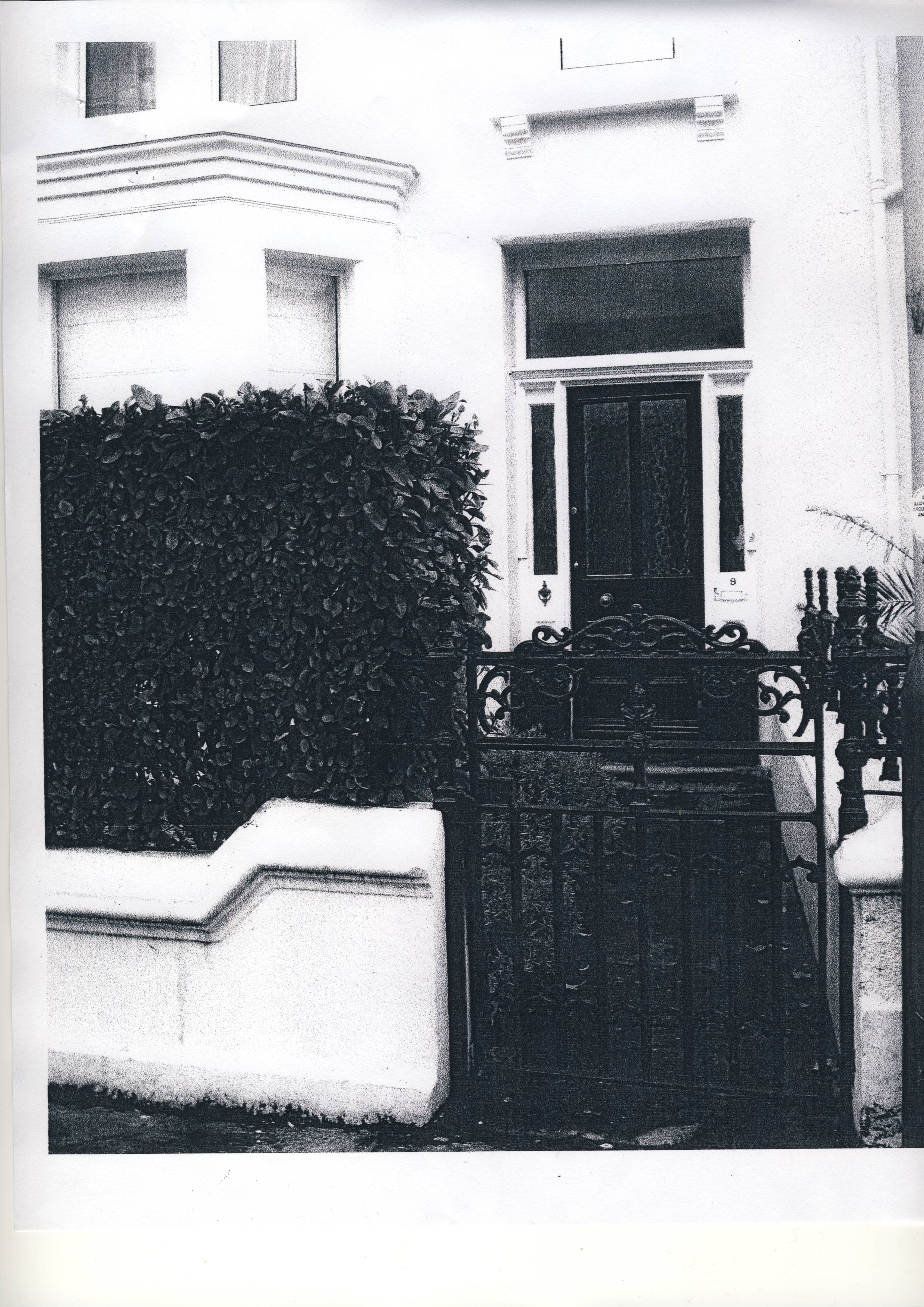 |
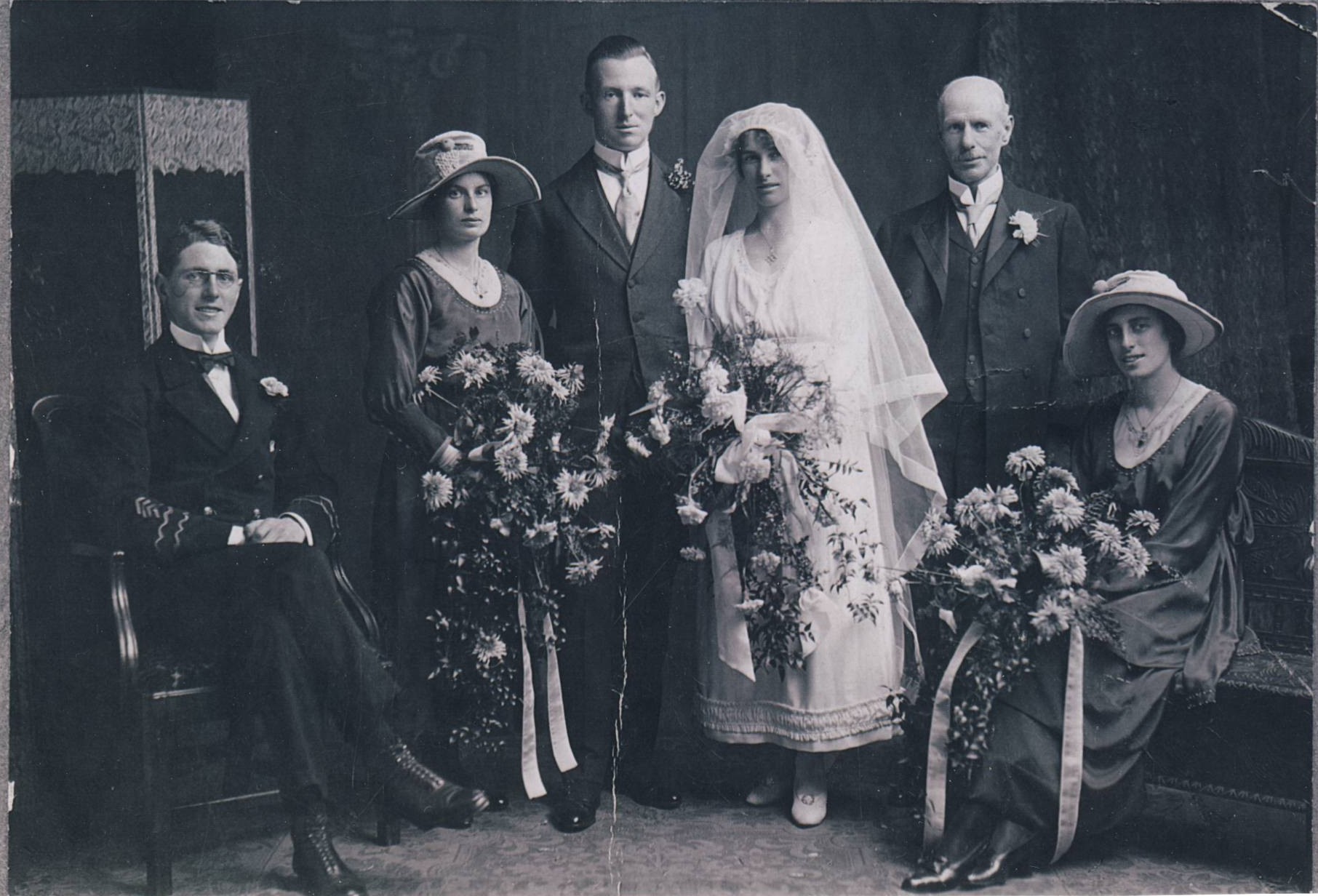 |
|
John Murray retired from the Scottish Prison Service on October 31, 1919, by which time he had achieved the rank of Steward Class I at Barlinnie Prison. He and his wife moved to the Isle of Man where some of Amy Louisa's relatives were living. The Wighton's lived at 9 Hawarden Avenue, Douglas as shown above left (as of 2005). The picture above right shows John Murray Wighton in a Hutcheon wedding party held in the Isle of Man in November, 1919. We believe that John Murray (you'll have to guess which one he is, I ain't telling you) was asked to give the bride away in the absence of the bride's father, William Hutcheon who died in 1913. William Hutcheon was John Murray's brother in law - a.k.a. John's wife's brother. The bride was Edith Hutcheon and she was marrying George Pert. The man sitting on the left is presumably the Best Man, but we don't have a name for him. Margaret Serzans examined the photos we had of the Hutcheon sisters, and was able to put names to faces: Alice Hutcheon as the bridesmaid on the left, and Amy Hutcheon, the bridesmaid on the right. John Murray Wighton died April 18, 1924 in his home at Hawarden Avenue, Douglas, Isle of Man. He was 66 years old at the time of his death which was caused by a valvular disease of the heart. His wife, Amy Louisa, was with him at the time. JMW was buried April 21 at Douglas Borough Cemetery, Grave M27. The inscription reads In loving memory of John Wighton, H.M.C.S., died 18th April, 1924 aged 66 years. |
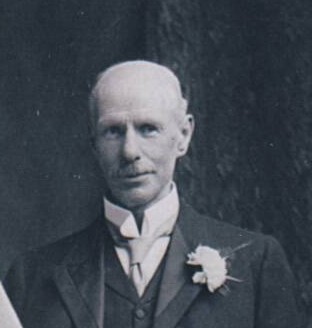 |
|
John signed a will on January 1, 1923 naming his wife as Executrix of his estate and leaving his entire estate to her. Witnesses to the will were Alice Burns Hutcheon (Chemist, 24 Derby Square), and Amy Campbell Hutcheon, Amy Louisa's nieces, both residents of Douglas, Isle of Man. His estate was valued at 700 pounds. At the time of his death, son Harry Latta Wighton was residing in Vancouver, Canada, and daughter Amy Louisa Hutcheon, wife of Harold Webster Trefry, was residing in Massachusetts. John's favourite story Three Scots and three Americans are traveling by train to a football game. At the station, the three Americans each buy tickets and watch as the three Scots buy only a single ticket. How are you three guys going to travel on only one ticket? asks one American. Watch and you'll see, answers Angus. They all board the train. The Americans take their respective seats but all three Scots cram into a bathroom and close the door behind them. Shortly after the train has departed, the conductor comes around collecting tickets. He knocks on the bathroom door and says Ticket please. The door opens just a crack and a single arm emerges with a ticket in hand. The conductor takes it and moves on. The Americans see this and agree it was quite a clever idea. So after the game, they decide to copy the Scots' trick on the return trip and save some money (being clever with money, and all that). When they get to the station, they buy a single ticket for the return trip. To their astonishment, the Scots don't buy any tickets at all! How are you going to travel without a ticket? says one perplexed American. Watch and you'll see, answers Angus. When they board the train, the three Americans cram into one bathroom and the three Scots cram into another bathroom nearby. Once the train leaves the station, one of the Scots leaves their bathroom and walks over to the bathroom where the Americans are hiding, knocks on the door, and says Tickets, please!
I, John Murray Wighton, through the signature below, do certify that this was, indeed, my favorite story. |
 |
|
I, Amy Louisa Wighton, through the signature below, do certify that my husband drove everyone crazy with this story. |
 |
|
Sources Serzans, Margaret (generation 9) Letter from Scottish Prison Service, Edinburgh to Margaret Serzans, May, 1971 Email from Carole Carine, Isle of Man, who researched John's gravesite and his home and sent results to Margaret Serzans, October 25, 2005. Letter by Amy Louisa Wighton (John Baxter's daughter-in law and John Murray Wighton's widow) to either her son Harry Latta Wighton and/or to her grandchildren (John Latta Wighton and Ella Wighton) around about 1939. A 1971 report commissioned from the Scots Ancestry Research Society by John Latta Wighton and Ella Peterson on the paternal ancestry of Harry Latta Wighton Isle of Man Government: Probate Form for John Murray Wighton's death as requested by Margaret Serzans Various letters from Ella Peterson (Wighton) to her brother John Latta Wighton Extract of an entry in a Register of Births: John Wighton, as provided by Margaret Serzans Various websites, including: ScotlandsPeople Database (http://www.scotlandspeople.gov.uk/) Some Signs and Plaques in Perth II: (http://www.alternative-perth.co.uk/signs2.htm) Leslie's Perth Directory, 1887 published by D. Leslie and costing 3 shillings. (http://deriv.nls.uk/dcn23/8569/85698399.23.pdf) John Murray Wighton's entry in the general directory is at page 192 of that directory, page 214 of the pdf file. Priory Place can be found in the Craigie portion of the directory at page 280 (#302 of the pdf file). Where to now? To read more about Generation 6 John Murray Wighton's immediate family, just click top to make a selection from Generation 6's genealogical table at the top of this page. The navigation buttons just below will give you quick access to biographies in other generations. |
| Home page Meigle Wightons | Generation #1 (John) | Generation #2 (William) | Generation #3 (Thomas) | Generation #4 (John) | Generation #5 (John Baxter) |
| Generation #6 (John Murray) | Generation #7 (Harry) | Under construction: Gen#8 | Under construction: Gen#9 | Under construction: Gen#10 | Under construction: Gen#11 |
| Index of the members of the Meigle Wightons | Index of the Essays in the Meigle Wightons website | Return to the Wighton Family Genealogy home page | |||